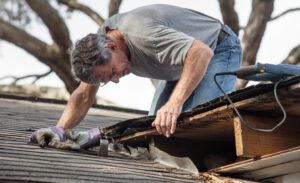Purchasing a new roof is a large investment. However, a durable roof can last for decades and improve your home’s curb appeal. Plus, it can reduce energy costs.
A bad roof can lead to structural damage, mold and pest invasions, and higher heating and cooling bills. It’s important to identify signs of wear and tear, such as sagging, shingle rot, dark streaks, or discoloration.
A new roof is one of the largest expenditures a homeowner will make for their home. A number of factors determine the exact price, but on average, the cost of roof replacement is around $11,000. This includes the cost of labor and materials.
The material that you choose will have the greatest impact on the final cost of your new roof. The most common choice is asphalt or composite three-tab shingles, which are affordable and can protect homes in a range of climates. Other options include clay, slate, and metal roofs, which are more expensive but provide superior protection. These types of roofs require specialized installation and can increase the cost of the project significantly.
In addition to the type of roofing you select, the cost will be influenced by the extent of the damage to your existing roof. If you have just a few loose or missing shingles, repairing them will be cheaper than replacing your entire roof. The cost will also vary depending on the size of your home and whether you opt for a flat or pitched roof.
Your roof’s pitch and any features like chimneys or skylights will affect how much it costs to replace your roof. The steeper and more angled your roof is, the more it will cost to replace. This is because steep roofs require more materials, painstaking work, and sometimes special equipment to install.
You will also need to consider other costs that are associated with a roof replacement, including the cost of removing the old roof and any necessary structural repairs. You should also factor in the cost of any permits that you may need to obtain for the job.
Some homeowners attempt to save money by performing the work themselves, but this is usually only a viable option for those who are very experienced and limited in the scale of their projects. Even then, it is often more cost-effective to hire a professional.
Materials
When it comes to roof replacement materials, there isn’t a one-size-fits-all option. Depending on climate, house style and budget, homeowners can select from a variety of roofing materials. WoW professionals are available to walk homeowners through the costs of each option so they can make an educated decision.
When a roof needs replacement, it is important to have a solid plan in place. This will help to keep the process as smooth as possible and ensure that all necessary steps are taken. The first step is to determine whether the roof can be repaired or if it must be replaced. This will help to determine the proper roofing materials and how long the project is likely to take.
The next step is to remove any shingles that are already on the roof. If the shingles are in good condition, it may be possible to lay new ones over them. This can save money and reduce the disruption to your home. However, it is important to discuss this with your roofing contractor as some municipalities may not allow two layers of shingles on a single roof.
Once the old shingles are removed, the roof decking will be exposed. This will be covered with underlayment to protect the wood from the elements. Felt paper, ice and water shields and other forms of underlayment are common options. Choosing an underlayment that is energy efficient will help to prevent temperature fluctuations and keep moisture from seeping into the home.
Next, the flashing will be installed. This is a metal material that stops moisture from getting where it shouldn’t. Roofers will use flashing around chimneys and where roofing planes meet, among other places. It is also helpful to install flashing along skylights and vent pipes.
Many homeowners choose to replace their entire roof, which is a huge undertaking but can significantly increase the value of your home. Other homeowners may only need to replace a small section of the roof, such as a leaky area or damaged shingles. When replacing a small portion of the roof, it is important to choose a high-quality and durable roofing material that will last for years to come.
Installation
Before the roofing team begins their work it’s important to prepare your house and yard. Move lawn equipment, patio furniture and cars away from the house to prevent them being damaged by falling debris. If you have pets, it’s best to take them to a friend’s house or a kennel service for the day of the roof replacement. Hammering and strange people in the yard will disturb them and they may step on a stray nail. If you have a garden, flowers or trees near your house cover them with large tarps to protect them from the thousands of nails that will fall off your roof.
A skilled roofing contractor will tear off your old roof and replace it with the new materials. They’ll install a water-repelling underlayment and a drip edge to protect the wood from moisture. They’ll also install a ridge cap that covers the peak of the roof and seals in the shingles. If your roof has vents or other penetrations, they’ll be sealed at this time as well.
Then the new shingles will be installed. The shingle installers will put the first course down, starting at the bottom of the roof and working up. The shingle installers will also install the flashing, which is usually made of metal, at the roof penetrations and the valleys of your home’s roof. Flashings will also be installed around any chimneys, skylights or other fixtures that touch the roof. A vapor barrier is often used in the valleys to prevent moisture from seeping into interior spaces.
When the roof is finished, the crew will clean up and remove all tarps and debris from your property. They’ll also remove any solar panels that are attached to your roof. Your driveway will be swept and any cars or other items that were moved during the process will be returned to their original locations. Your roofing company will dispose of all the old shingles and other debris in a dumpster, leaving your home cleaner than it was before they started working. A licensed and insured roofing contractor will follow the proper steps to ensure that your new roof is a durable and lasting part of your home.
Maintenance
A roof is a big investment, and it’s important to maintain it. Regular maintenance will prevent expensive repairs and prolong the life of your roof. This will also help reduce energy costs. In addition, a well-maintained roof will help protect your belongings and increase the value of your home.
Maintenance procedures vary depending on the roof type and condition. A thorough inspection is usually required to determine the condition of your roof. This may include looking at the ground, inside the attic, and on a ladder to identify issues like leaking areas or loose or missing shingles. It is also helpful to look at the exterior of your building for signs of water damage, such as soft water spots or stains.
The roofer will begin by examining the condition of your roof’s sheathing, which is the wood substrate that supports the roofing materials. If the sheathing is damaged, it will need to be replaced. The roofer will also install a felt or breathable synthetic underlayment to create an inner barrier against moisture penetration. The next step is to install flashing. Flashing is used to seal gaps around chimneys, wood stove pipes, and vents as well as along hip and valley areas of the roof. Lastly, the shingles will be installed. These are the final layers of protection and give your roof its finished look.
Proactive maintenance has been shown to significantly extend the service life of a roof, reducing the likelihood that it will need to be replaced prematurely. It will also keep you in compliance with your manufacturer’s warranty. A maintenance program should include a schedule that includes routine inspections, cleaning, and repair services. In addition, the program should include documentation such as pictures, roof dimensions, and applied systems.
A comprehensive maintenance program will include a dedicated team that will visit your facility on an established schedule. These teams will consist of a minimum of (1) roof mechanic and one laborer. The team will be familiar with your building and all of its relevant systems and the installation and repair procedures that have been used. A roster will be submitted to you which includes the name and contact information of all the mechanics that will be performing the maintenance. You will be able to run background checks on all of the roster members if you choose.
